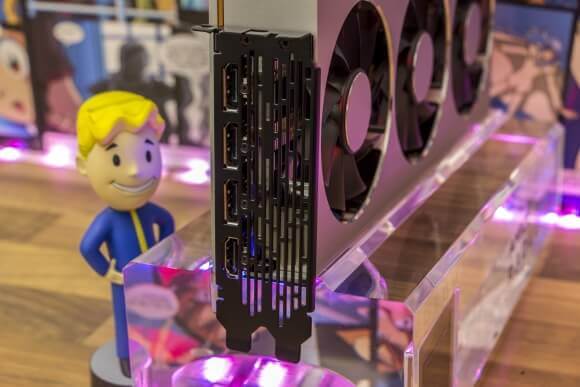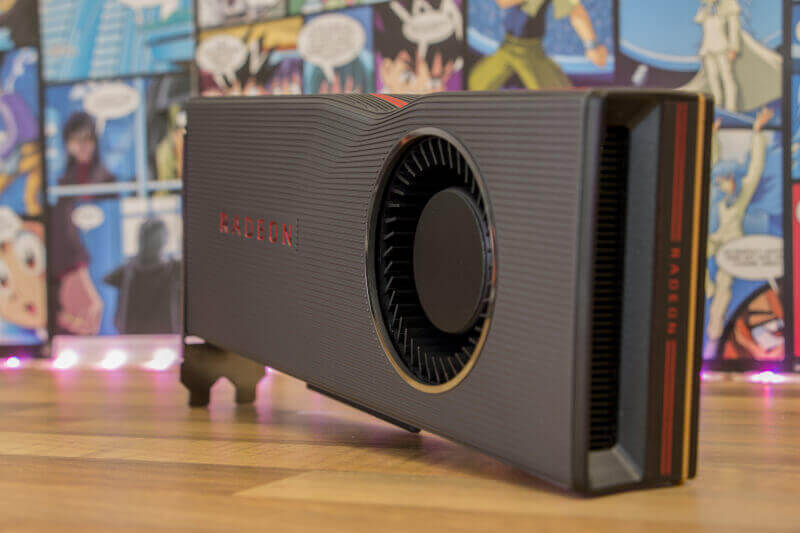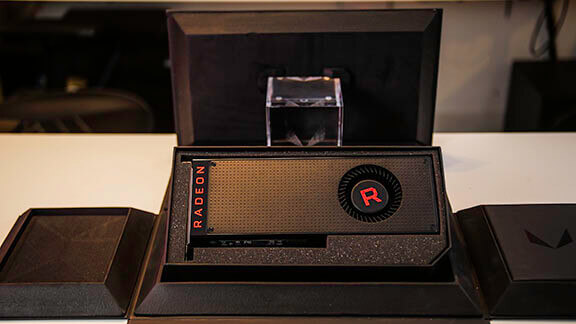AMD Guide: The Best AMD GPU Money Can Buy

Over the years, AMD has established themselves significantly on the budget to mid-tier markets, and they continue this fine trend with their newest installments, the AMD Radeon RX 5700 and RX 5700 XT. At the same time, they even manage to raise the performance level considerably. If you’re on the lookout for a good GPU that doesn’t cost a fortune, AMD is an obvious candidate - especially if you are sitting on a 1440p or 1080p display.
We’ve gathered all of the best graphics cards from Team Red, and listed them below. This way, you will be able to get a good overview of the GPU offerings from AMD.
AMD Radeon RX 5700
Stream processors: 2.304, Core Clock: 1.465 MHz (1.725 MHz boost), Memory: 8 GB GDDR6 | Memory frequency: 14 Gbps, Power connector(s): 1 x 8-pin og 1 x 6-pin, Connectivity: 1 x DisplayPort 1.4 with DSC, 1 x HDMI with 4K60 Support
From our AMD Radeon RX 5700 review:
The RX 5700 has proven to be a really good entry-level card that is capable of matching even an RTX 2060. So it’s definitely a card that is worth considering, if you are so inclined. The performance was very satisfying, especially when considering what it is intended for. Add to that the use of a 7 nm chip die, which gives a wonderful power efficiency and the PCIe Gen. 4 architecture, as well as everything that the RDNA architecture has to offer.
Pros:
Fine performance in relation to power draw
Fine MSRP
PCIe Gen. 4 technology
RDNA and all that it brings with it
The cooler does a good job
The card overclocked reasonably
Cons:
The design is a bit plain
Lack of ray tracing
The air intake is choked down a bit compared to the XT version
AMD Radeon RX 590
Stream processors: 2.304, Core Clock: 1.469 MHz (1.545 MHz boost), Memory: 8 GB GDDR5, Memory frequency: 8 Gbps, Power connector(s): 1 x 8-pin 1 x 6-pin, Connectivity: 2 x DisplayPort 1.4, 2 x HDMI 2.0, 1 x DVI
From our PowerColor Red Devil Radeon RX 590 8 GB review:
First and foremost, let’s talk about the build quality. PowerColor has put together a really solid card. The front cover is made in plastic onto which a metal frame has been installed. This makes the card feel solid and of high quality. They’ve made use of a sapphire black PCB and high-quality 60 amp power phases, which both looks great, but also makes the card very stable. The cooling solution consists of a large heat sink that covers the entire length of the PCB and it touches the GPU chip directly. The heat sink is nickel plated, which makes it look very appealing. All in all, it’s a very nice card, despite the fact that the card sports the worn-out red/black color scheme. This inherently limits your aesthetical options since a more neutral design with RGBs would be easier to fit into one’s build. Also, I wonder why they’ve decided to keep the DVI connector instead of making room for a USB 3.1 connector now that the card is specified as VR Ready.
Pros:
Solid card with high build quality
Metal frame adds to the overall sense of quality
Smart choice of power phases
Reasonable choice for 1080p gaming
Overclocked well
Cons:
Lack of USB 3.1 interface
It’s a power hungry card relative to its performance
AMD Radeon RX 5700 XT

Stream processors: 2.560, Core Clock: 1.605 MHz (1.905 MHz boost), Memory: 8 GB GDDR6, Memory frequency: 14 Gbps, Power connector(s): 1 x 8-pin og 1 x 6-pin, Connectivity: 1 x DisplayPort 1.4 with DSC, 1 x HDMI with 4K60 Support
Read our review of the AMD Radeon RX 5700 XT.
Extract:
Provided that the price is going to stick, we can see that the Radeon RX 5700 XT probably will be cheaper than the RTX 2070. At least, it won’t be more expensive, and at the same time, it offers PCIe Gen. 4, a 7 nm chip die and GDDR6 VRAM. So, with the RX 5700 XT comes the newest technology, good performance and fine power optimization. 180 W under full load is a great power draw in relation to the performance provided.
So, to conclude, I find AMD deserving of a great score of 9, and if the price holds up, I’d also stand by a Safe Buy Award. I find that the Radeon RX 5700 XT is a great addition to the GPU market, and I wouldn’t hesitate investing in this card for a future AMD build.
Pros:
Nice new design of the reference cooler
Fine performance in relation to power draw
The blower style cooler ran silent during the test
7 nm chip die
The Radeon software offers a lot of image optimization options without any big performance loss
Cons:
Won’t really overclock
Lack of ray tracing
AMD Radeon VII
Stream processors: 3.840, Core Clock: 1.400 MHz (1.750 MHz boost), Memory: 16 GB HBM2, Memory frequency: 4 Gbps, Power connector(s): 2 x 8-pin, Connectiviry: 3 x DisplayPort 1.4, 1 x HDMI 2.0
Read our view of the AMD Radeon VII.
Extract:
All in all, I will reward the AMD Radeon VII GPU with a solid 8.5 score. There is room for improvement, and there is enough room for rewarding future AIB releases, provided these offer custom clock frequencies, better drivers, and performances that fully match, or even surpass, 2080 to a larger degree than we’ve seen here.
But AMD deserve the credit for introducing the 7nm and HBM2 into the game. AMD Radeon VII is a genuinely solid card, and, if the price stabilizes, AMD and future AIB cards could easily deserve even higher scores.
Pros:
Really nice design
The new reference cooler is a good upgrade
7 nm architecture
16 GB HBM2 VRAM
Cons:
Lack of USB 3.1 interface
Despite the new coolers is a breath of fresh air, it was quite noisy under full load
The performance doesn’t quite live up to AMD’s hype
It runs a bit warm
AMD Radeon RX Vega 64

Stream processors: 4.096, Core Clock: 1.247 MHz (1.546 MHz boost), Memory: 8 GB HBM2, Memory frequency: 1,89 Gbps, Power connector(s): 2 x 8-pin, Connectivity: 3 x DisplayPort 1.4, 1 x HDMI 2.0
From our AMD RX Vega 64 review:
It’s great that these cards are now available, and on the European market, we are fortunately not subject to the increased prices as they are in other areas. This means that the RX Vega 64, in its standard edition, which we’ve tested, can be found for less than $600, which makes it an interesting opponent to the GTX 1080.
Pros:
Subtle design if you want something different than your typical “gamer” look
HBM2 RAM
Cons:
The reference design isn’t exactly quiet
Power hungry
Disappointed in some of our initial benchmark runs
We decided to not go any further back in time when compiling this list of AMD GPUs.
Latest graphics card
-
17 Aprgraphics card
-
03 Aprgraphics card
These graphics cards are the most popular
-
03 Aprgraphics card
Intel ARC Battlemage GPU Details
-
02 Aprgraphics card
Increased demand for Nvidia's graphics cards in Ch
-
25 Margraphics card
MSI RTX 4060Ti Gaming X Trio
-
21 Margraphics card
Intel improves performance with new GPU Driver
-
19 Margraphics card
Nvidia launches their latest Blackwell AI Chip
-
13 Margraphics card
First demo of DirectX 12 Ultimate's Work Graphs
Most read graphics card
Latest graphics card
-
17 Aprgraphics card
NVIDIA launches RTX A400 and A1000
-
03 Aprgraphics card
These graphics cards are the most popular
-
03 Aprgraphics card
Intel ARC Battlemage GPU Details
-
02 Aprgraphics card
Increased demand for Nvidia's graphics cards in Ch
-
25 Margraphics card
MSI RTX 4060Ti Gaming X Trio
-
21 Margraphics card
Intel improves performance with new GPU Driver
-
19 Margraphics card
Nvidia launches their latest Blackwell AI Chip
-
13 Margraphics card
First demo of DirectX 12 Ultimate's Work Graphs






